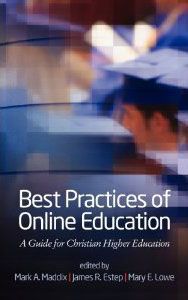 “Fifteen years ago, many academic leaders thought it was impossible for students to have truly meaningful community interaction in an online distance education environment. Ironically, one of the biggest struggles today for many traditional campus professors is to keep their students off Facebook during class!”
“Fifteen years ago, many academic leaders thought it was impossible for students to have truly meaningful community interaction in an online distance education environment. Ironically, one of the biggest struggles today for many traditional campus professors is to keep their students off Facebook during class!”
This is the opening paragraph of “Social Presence in Online Learning,” my chapter in a new book called Best Practices of Online Education: A Guide for Christian Education. Edited by Mark A. Maddix, James R. Estep, and Mary E. Lowe. Published by Information Age (2012).
I was asked to write the chapter to describe the tremendous potential of online learning communities, but I went even farther to describe “situated learning” because I believe that truly church-based theological education programs of Antioch School partners are the best learning communities.
Here is my closing paragraph: “In conclusion, it is clear that social presence is a crucial dimension of effective online learning. This article has focused on how distance can be broken down in online learning and how presence can be supported and optimized in online and real life social contexts. Hopefully the consideration of historical perspective, learning theory, and best practices (especially next best practices) can be used to stimulate improvement for weak programs and to strengthen programs that are already strong.”
Here are two excerpts from the chapter that were posted on the Distance-Educator.com website.
The first, called “Social Presence in Online Learning” describes the distance education context and learning theory. The chapter goes into more detail on theological education in particular.
The second, called “Best Practices in Online Learning” describes best practices and what I call “next best practices” (things that aren’t being done widely, but should). The chapter in the book also includes sections on common practices and worst practices.